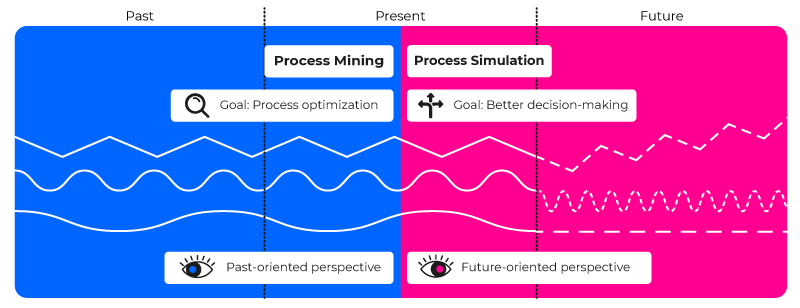 What if we automated one process step in production? What if we used twice as many employees for transport? What if ...? These scenarios can be tested in a virtual environment using business process simulation to come to a clear decision. The data situation is crucial for a reliable and well-founded process simulation. This is where process mining comes into play. Combing both disciplines – process mining and business process simulation – enables easier decision making and targeted improvements in business processes. But first: What is business process simulation and what is process mining?
What if we automated one process step in production? What if we used twice as many employees for transport? What if ...? These scenarios can be tested in a virtual environment using business process simulation to come to a clear decision. The data situation is crucial for a reliable and well-founded process simulation. This is where process mining comes into play. Combing both disciplines – process mining and business process simulation – enables easier decision making and targeted improvements in business processes. But first: What is business process simulation and what is process mining?
Business Process Simulation
Business Process Simulation (BPS) refers to the simulation of the behavior of business processes within a virtual environment. The real processes are represented by a simulation model, a digital twin. Using this simulation, companies can test and visualize different scenarios to see how changes affect efficiency, resource utilization or other key performance indicators before they are implemented.
In the past, BPS simulation models were created manually using time-consuming process documentation, stopwatches and expert interviews. The problem with this is the many subjective influences that lead to distortion of the processes. In addition, this manual method cannot capture more complex processes, which in reality take place across a wide variety of departments, systems and locations.
The closer to reality the process simulation is, the more valuable it is. BPS is therefore now often combined with process mining technology, which objectively analyzes the current situation of business processes based on data. Process mining thus creates the necessary data basis for business process simulation.
Process Mining
Process mining is a technology for systematically analyzing and evaluating business processes with the aim of uncovering potential for improvement and implementing measures. Instead of recording process data manually, it is extracted from IT systems using event logs. The data basis is therefore objective and comprehensive, as all processes that run through various programs and systems are included.
Process mining can create a digital twin, in other words a virtual copy of an organization's real business processes. Through visualizations and key figures, process mining offers the possibility of discovering the actual processes, recognizing deviations from target processes and identifying inefficiencies and waste. The findings of these analyses can be used to make targeted improvements to processes to increase efficiency and save resources.
What is the difference between Process Mining and BPS?
Process mining generally has a backward-looking perspective, as historical data is extracted from the IT systems in order to understand the current as-is processes. The aim is to uncover inefficiencies and optimization potential.
Business process simulation, on the contrary, has a future-oriented perspective, as different future scenarios and their effects are simulated based on the current processes. The aim of these "what-if scenarios" is to make decisions more easily and reliably.

How do BPS and Process Mining work in combination?
The two disciplines fit together like two pieces of a puzzle and complement each other. Process mining as a framework provides the data basis and creates a digital twin. Various analyses can be used to identify optimization potential in business processes. This is where business process simulation comes in, simulating and testing how these potential changes affect the key figures of the business processes.
Business process simulation thus supplements process mining with a future-oriented perspective that enables companies to model, test and validate various scenarios based on the real findings obtained through process mining.
Webinar on Demand | "What if" you knew how changes to processes due to external influences or adjustments would affect the output? You would be able to act proactively and simulate different scenarios and characteristics. A digital assistant would calculate all combinations and provide you with the answer to your what-if questions. Too good to be true? Fortunately not!

